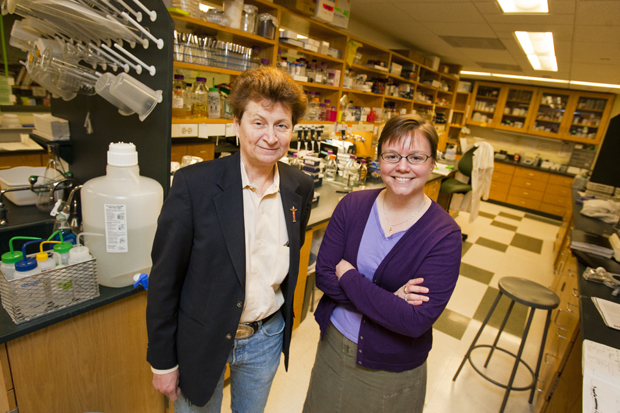Form and function in enzyme activity

Many industrial chemistry applications, such as drug or biofuel synthesis, require large energy inputs and often produce toxic pollutants. But chemistry and chemical biology professor Mary Jo Ondrechen said enzymes — proteins that increase the rate of chemical reactions in the body — could be used to effectively replace standard industrial processes.
“Enzymatic reactions are cleaner, produce fewer byproducts and use less energy,” she explained. But attempts to replicate natural enzymes for industrial applications are limited by our incomplete knowledge of these proteins.
Ondrechen and Penny J. Beuning, an assistant professor of chemistry and chemical biology, have received a three-year, $565,000 grant from the National Science Foundation to develop a better understanding of enzyme activity.
“If you want to design proteins to catalyze a particular reaction, it’s good to understand how they work,” said Ondrechen.
Enzymes, she explained, are made up of a string of amino acids coded by the gene sequence. Each amino acid has a different role in the protein: Some are structurally important while others are required for the enzyme’s catalytic properties.
“There are cavities on the surface of a protein where a molecule can come in and sit down,” Ondrechen said. “The enzyme does a reaction on it and the product goes away.”
The current body of research on enzyme activity mostly focuses on the amino acids in that cavity, which come into direct contact with the reactive molecule. But over the years, some research has suggested that amino acids far away from the active site also play a role in catalysis.
Ondrechen’s team, using a method she developed 10 years ago, will be able to predict which remote amino acids will impact reactivity. Beuning’s team will test these predictions experimentally.
“My lab is really interested in specificity of enzymes,” Beuning said. “We look enzymes and figure out how they recognize their substrates.”
To do this, her team takes a protein engineering approach in which they manipulate the enzyme’s composition and observe how it affects its function.
Beuning’s experimental data can be used to train the computational method to make even better predictions about which amino acids are important to catalysis.
“There is a nice synergy between our interests,” she said. “We can take the computational work from Ondrechen’s lab, add the experimental work to it and then take the experimental results and say, ‘Did it work? Are there subtleties that we’re missing?’”
By building a library of enzymes known to have remote amino-acid activity, the group can eventually begin to answer fundamental research questions in the quest to improve industrial enzymatic chemistry techniques.





